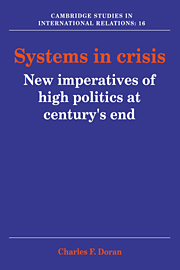Book contents
- Frontmatter
- Contents
- Preface
- Acknowledgments
- Introduction: new perspectives on the causes and management of systems crisis
- Part 1 Dynamics of state power and role: systems structure
- 1 What is power cycle theory? Introducing the main concepts
- 2 Measuring national capability and power
- 3 The cycle of state power and role
- Part 2 Dynamics of major war and systems transformation
- Part 3 Dynamics of general equilibrium and world order
- Part 4 Systems transformation and world order at century's end
- Appendix: Mathematical relations in the power cycle
- References
- Index
1 - What is power cycle theory? Introducing the main concepts
Published online by Cambridge University Press: 08 September 2009
- Frontmatter
- Contents
- Preface
- Acknowledgments
- Introduction: new perspectives on the causes and management of systems crisis
- Part 1 Dynamics of state power and role: systems structure
- 1 What is power cycle theory? Introducing the main concepts
- 2 Measuring national capability and power
- 3 The cycle of state power and role
- Part 2 Dynamics of major war and systems transformation
- Part 3 Dynamics of general equilibrium and world order
- Part 4 Systems transformation and world order at century's end
- Appendix: Mathematical relations in the power cycle
- References
- Index
Summary
The Preface, with broad strokes, captures the main ideas and arguments of this book. The Introduction provides analytic perspective, unravelling deceptively similar concepts and arguments that may obscure that panorama. This chapter sets the focus for understanding, delineating the parameters of the analysis and the steps by which the theory is developed and the policy conclusions derived. From its inception, power cycle theory sought to integrate the great conceptual opposites of international politics: actor versus system; absolute versus relative power; static versus dynamic structural analysis; complementarity versus competitiveness; and state interests versus capabilities. The problem of peaceful change demands holistic assessment.
Power cycle theory explains the evolution of systemic structure via the cyclical dynamic of state rise and decline. It is thus a theory of the international political development of the nation–state in the modern system and a theory of changing systemic structure. For the “power cycle” concept encompasses both the state and the system in a single dynamic, generalizable across states and across periods of history, which expresses the structural change at the two levels simultaneously. The power cycle can be analyzed on each level by means of a variety of approaches, from the facts of history and an understanding of international political behavior, to mathematical analysis and quantitative empirical assessment.
[…]
Information
- Type
- Chapter
- Information
- Systems in CrisisNew Imperatives of High Politics at Century's End, pp. 19 - 43Publisher: Cambridge University PressPrint publication year: 1991
